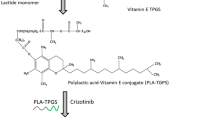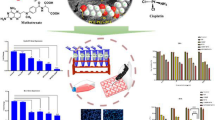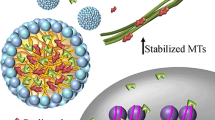Abstract
Amphiphilic copolymer monomethoxy poly(ethylene glycol)-poly(caprolactone)-d-α-tocopheryl polyethylene glycol 1000 succinate (MPEG-PCL-TPGS) was prepared. In the present study, MPEG-PCL-TPGS was used as a novel nanovehicle for the delivery of paclitaxel (PTX) in the treatment of resistant lung cancers. The PTX-loaded MPEG-PCL-TPGS (PTX/MPT) micelles exhibited sustained release profile (168 h) with accelerated drug release at acidic pH conditions. The blank polymeric micelles showed excellent biocompatibility with cell viability of >85 %, making it suitable for all in vivo applications. PTX/MPT micelles displayed superior cytotoxicity in A-549 lung cancer cells than that of free PTX. The selective delivery of PTX to cancer cells resulted in enhanced cancer cell death. The PTX/MPT micelles showed higher cellular uptake via endocytosis pathways. The PTX-bound micelles preferentially arrested the cells at G2/M phase and showed a marked increase in sub G1 cell population (∼20 %). The pharmacokinetic study revealed a long blood circulation for PTX/MPT micelles. Finally, micellar formulation showed a remarkable tumor suppression effect in resistant A549/Taxol cells bearing xenograft nude mice along with no toxicity profile. The results indicate that the PTX-loaded biocompatible polymeric nanosystem could act as a potential delivery system for the treatment of lung carcinomas.







Similar content being viewed by others
References
Jemal, Bray F, Center MM, Ferlay J, Ward E, Forman D. Global cancer statistics. CA Cancer J Clin. 2011;61:69.
Parkin DM, Bray F, Ferlay J, Pisani P. Global cancer statistics. CA Cancer J Clin. 2005;55:74–108.
Wao H, Mhaskar R, Kumar A, Miladinovic B, Djulbegovic B. Survival of patients with non-small cell lung cancer without treatment: a systematic review and meta-analysis. Syst Rev. 2013;2:10.
Govindan R, Page N, Morgensztern D, Read W, Tierney R, Vlahiotis A, et al. Changing epidemiology of small-cell lung cancer in the United States over the last 30 years: analysis of the surveillance, epidemiologic, and end results database. J Clin Oncol. 2006;24:4539.
Reck M, Heigener DF, Mok T, Soria JC, Rabe KF. Management of non-small-cell lung cancer: recent developments. Lancet. 2013;382:709–19.
Curran Jr WJ, Paulus R, Langer CJ, Komaki R, Lee JS, Hauser S. Sequential vs. concurrent chemoradiation for stage III non-small cell lung cancer: randomized phase III trial RTOG 9410. J Natl Cancer Inst. 2011;103:1452–60.
Shobha S, Sarah D. Targeted therapy and new anticancer drugs in advanced disease. Thorac Surg Clin. 2013;23:411–9.
Liu J, Meisner D, Kwong E, Wu XY, Johnston MR. Translymphatic chemotherapy by intrapleural placement of gelatin sponge containing biodegradable paclitaxel colloids controls lymphatic metastasis in lung cancer. Cancer Res. 2009;69:1174–81.
Tien H, Dahlberg SE, Sandler AB, Brahmer JR, Schiller JH, Johnson DH. Prognostic Models to predict survival in non-small cell lung cancer patients treated with first-line paclitaxel and carboplatin with or without bevacizumab. J Thorac Oncol. 2012;7:1361–8.
Videira M, Almeida AJ. Preclinical evaluation of a pulmonary delivered paclitaxel-loaded lipid nanocarrier antitumor effect. Nanomedicine. 2012;8:1208–15.
Yang R, Shim WS, Cui FD, et al. Enhanced electrostatic interaction between chitosan-modified PLGA nanoparticle and tumor. Int J Pharm. 2009;37:142–7.
Zhang ZP, Lee SH, Gan CW, Feng SS. In vitro and in vivo investigation on PLA-TPGS nanoparticles for controlled and sustained small molecule chemotherapy. Pharm Res. 2008;25:1925–35.
Shieh YA, Yang SJ, Wei MF, Shieh MJ. Aptamer-based tumortargeted drug delivery for photodynamic therapy. ACS Nano. 2010;4:1433–42.
Wang T, He N. Preparation, characterization and applications of low molecular-weight alginate–oligochitosan nanocapsules. Nanoscale. 2010;2:230–9.
He N, Wang T, Jiang L, Wang D, Hu Y, Zhang L. Therapy for cerebral ischemic injury with erythropoietin-containing nanoparticles. J Nanosci Nanotechnol. 2010;10:5320–3.
Gou M, Wei X, Men K, et al. PCL/PEG copolymeric nanoparticles: potential nanoplatforms for anticancer agent delivery. Curr Drug Targets. 2011;12:1131–50.
Huang LQ, Chen HB, Zheng Y, Song XS, Liu R, Liu KX, et al. Nanoformulation of d-α-tocopheryl polyethylene glycol 1000 succinate-β-poly(ε-caprolactone-ran-glycolide) diblock copolymer for breast cancer therapy. Integr Biol. 2011;3:993–1002.
Wang JL, Sun J, Chen Q, et al. Star-shaped copolymer of lysine-linked di-tocopherol polyethylene glycol 2000 succinate for doxorubicin delivery with reversal of multidrug resistance. Biomaterials. 2012;33:6877–88.
Li PY, Lai PS, Hung WC, Syu WJ. Poly(l-lactide)-vitamin E TPGS nanoparticles enhanced the cytotoxicity of doxorubicin in drug-resistant MCF-7 breast cancer cells. Biomacromolecules. 2010;11:2576–82.
Tsai HY, Chiu CC, Lin PC, Chen SH, Huang SJ, Wang LF. Antitumor efficacy of doxorubicin released from crosslinked nanoparticulate chondroitin sulfate/chitosan polyelectrolyte complexes. Macromol Biosci. 2011;11:680–8.
Brannon-Peppas L, Blanchette JO. Nanoparticle and targeted systems for cancer therapy. Adv Drug Deliv Rev. 2004;56:1649–59.
Storm G, Belliot SO, Daemen T, Lasic DD. Surface modification of nanoparticles to oppose uptake by the mononuclear phagocyte system. Adv Drug Del Rev. 1995;17:31–48.
Maeda H, Bharate GY, Daruwalla J. Polymeric drugs for efficient tumortargeted drug delivery based on EPR-effect. Eur J Pharm Biopharm. 2009;71:409–19.
Acknowledgment
The work was supported by the Ministry of Health, Xiangya Hospital Central South University, China.
Conflicts of interest
None
Author information
Authors and Affiliations
Corresponding author
Rights and permissions
About this article
Cite this article
Zhang, XY., Zhang, YD. Enhanced antiproliferative and apoptosis effect of paclitaxel-loaded polymeric micelles against non-small cell lung cancers. Tumor Biol. 36, 4949–4959 (2015). https://doi.org/10.1007/s13277-015-3142-7
Received:
Accepted:
Published:
Issue Date:
DOI: https://doi.org/10.1007/s13277-015-3142-7




